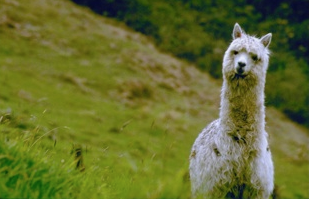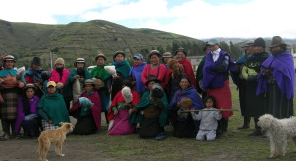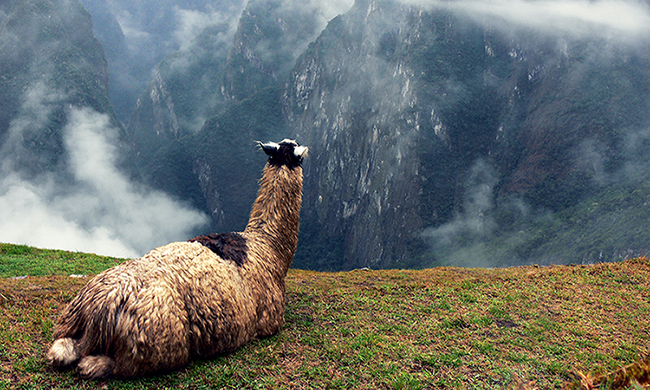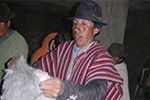By Anne Grigg
Tourists returning from Andean South America will usually sport some sort of “alpaca item”: gloves, sweaters, hats, socks, all with pre-columbian-style designs, inevitably including the form of an alpaca. However, buyers rarely glimpse the truth behind this iconic industry—that the alpaca as well the artisans who work with a centuries-old tradition are in peril. But, like in centuries past, alpacas fit perfectly into the Andean environment and the needs of our modern lifestyles. Thanks to the efforts of two Ecuadorian initiatives, it is reappearing, returning to its place renewed, becoming an image not of the past, but rather of hope for the future.
Alpacas were domesticated from the wild vicuña around 7,000 years ago. The Inca civilization became experts in managing alpacas, using them as beasts of burden, a crucial source of protein, fuel (from their waste pellets), and utilizing their fiber for clothing. Processing alpaca fiber was an essential and all-inclusive part of Incan culture. The herders had to be experts in selective breeding in order to guarantee the softest wool, while the women were master spinners and weavers.
When the Spanish conquistadors arrived, they did not appreciate these “long-necked sheep,” so the native Andean animal was driven out to make room for cattle, sheep, pigs, and horses. Peru, having a more concentrated population of alpacas and “alpaqueros,” was able to retain some of its heritage, and today it hosts about 90% of the world’s alpaca. On the other hand, Ecuador lost its alpaca culture almost entirely.

All Things Alpaca is a family enterprise led by Patricia Espadero Ponce, an Ecuadorian veterinarian, and her husband Stuart White. They have been the leaders in bringing alpaca culture back to life in Ecuador. Utilizing alpaca’s full potential, they produce textiles, yarns, and organic fertilizer. Their expertise—crucial when keeping in mind that fleece value depends on seven different quality grades and 22 natural colors, all maintained by meticulous breeding systems—is a source of hope in restoring quality alpaca breeding and artisanal methods.
Additionally, All Things Alpaca’s 600 head alpaca herd helps to maintain the Mazar Wildlife Reserve. This reserve provides a habitat for many endangered species, such as the Andean bear and puma and it conserves a healthy, highly endangered paramo ecosystem that is a crucial source of water. While introduced livestock like cattle and sheep damage the landscape (eating and trampling the native, sponge-like grasses), alpacas co-evolved with this fragile ecosystem, and are physiologically designed to serve and restore the landscape. Their padded feet do not trample the fragile grasses, they eat scrub vegetation other livestock won’t touch (eating from the stalk and leaving the roots intact), and leave their waste as fertilizer to help the cycle continue.

Stuart and Patricia have also shared their vast experience with Felipe Segovia and Lorena Pérez from Paqocha, a fellow alpaca initiative whose mission is to use the recovered knowledge to create a sustainable trade circuit in which all of the artisans working with traditional processes can thrive. A huge barrier to using the alpaca market as a viable option for relieving poverty in highland communities is the market itself. In Peru, even the highest quality fiber fails to bring in sufficient funds due to intermediaries, small herds, and little bargaining power in the communities. While finished alpaca products retail at premium prices, Peruvian alpaqueros earn an average of $600 for a year of tending to their herds.
In order to create a sustainable loop, Lorena and Felipe have identified herders who want to sell their fleece at fair prices, women who want to spin the thread for extra income, and other groups of women with the ancestral knowledge and disposition to knit different designs with Lorena once a week. The finished products command high prices and Paqocha distributes the profit more evenly across its supply chain. As Lorena explained in talking about their process, “In Peru we saw an alpaca sweater on sale for $80, but we know from market research that they paid the herder around $2 for a whole year’s worth of work to create that sweater. They pay nothing for the fiber, nothing to spin it, nothing to weave it, and charge $80. We could be doing the same and earn more, but then we wouldn’t be happy.”
[clear]
[clear]
[clear]
[rev_slider paqocha]
[clear]
[clear]
[clear]
This animal’s many social and environmental benefits are derived from the fact that it actually belongs in the Andes. Working with alpacas fits naturally with the local ecosystems, as shown by All Things Alpaca’s successes in conservation, and also fits with Andean cultures and lifestyles. Although Lorena is fashion-conscious (Paqocha has been displayed at the Ethical Fashion Show in Paris, among other events), she works her designs around the weavers’ needs: “We try not to interrupt the community members’ daily lives. We won’t impose what yarn we want for our designs, but will make our designs around what they want to provide…There are women who spin fine yarn and thick yarn, who sell 1 kilogram or 10 grams.¨ Keeping with the Incan tradition, processing alpaca fiber icomplements a woman’s daily life, without necessarily defining it.
In a region characterized by poverty, harsh conditions, and harsher prospects for the future under climate change, these useful creatures and their valuable fleece present many hopeful opportunities for the páramo and its inhabitants. For their part, these two initiatives show that socially and environmentally conscious alpaca industries are viable options that could redefine sustainability in the Andes.
Check out the profiles of All Things Alpaca, Paqocha, and other sustainable producers on Canopy Bridge.
Feature photo by Roger Nelson
Paqocha, Ecuador
Canopy Bridge User
Wildlife Reserve
All Things Alpaca Ecuador
[clear]





